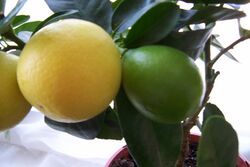Biology:Limequat
| Limequat | |
|---|---|

| |
| A Eustis Limequat | |
| Scientific classification | |
| Kingdom: | Plantae |
| Clade: | Tracheophytes |
| Clade: | Angiosperms |
| Clade: | Eudicots |
| Clade: | Rosids |
| Order: | Sapindales |
| Family: | Rutaceae |
| Genus: | Citrus |
| Species: | C. × floridana
|
| Binomial name | |
| Citrus × floridana (J. Ingram & H. Moore) Mabb.
| |
The limequat (Citrus × floridana) is a citrus hybrid that is the result of a cross between the Key lime and the kumquat, hybridized by Walter Tennyson Swingle in 1909.[1]
Description
It is a small tree that grows into a contained bushy form. The leaves are characteristically citrus-like. The limequat produces an abundance of fruit even at a young age. The fruit is small, oval, greenish-yellow and contains seeds or pips. It has a sweet-tasting skin and a bitter-sweet pulp with a flavor similar to limes. The fruit can be eaten whole or the juice and rind can be used to flavor drinks and dishes. It has considerable amounts of vitamin C and is highly acidic.
This plant is now grown in Japan , Israel, Spain , Malaysia, South Africa , the United Kingdom and the United States in California , Arizona, Florida, and Texas . The fruit can be found, in small quantities, during the fall and winter months in the United States, India and Japan .
Limequats can be grown indoors or outdoors providing the temperature stays between 10 °C and 30 °C (50 °F to 86 °F). They are fairly small and can be planted in containers or pots, in well-drained fertile soil. Plants grow fairly slowly and flower and fruit for 5–7 months, then rest for 5–7 months.
Limequats are more cold-hardy than limes but less cold-hardy than kumquats.
Limequats are used in cocktails and fruit salads, and can be candied whole. They can be cooked if the seeds are removed, as they impart a bitter taste, and they can also be made into conserves.[2]
Varieties
There are three different named cultivars of limequats:
- Eustis (Citrus japonica (synonym Fortunella japonica) × Citrus aurantiifolia) - Key lime crossed with round kumquat, the most common limequat. It was named after the city of Eustis, Florida.
- Lakeland (Citrus japonica × Citrus aurantiifolia) - Key lime crossed with round kumquat, different seed from same hybrid parent as Eustis. Fruit is slightly larger and contains a few fewer seeds than Eustis. It was named after the city of Lakeland, Florida.
- Tavares (Citrus japonica 'Margarita' × Citrus aurantiifolia) - Key lime crossed with oval kumquat (though there is some speculation that it is actually a lemon/kumquat hybrid), fruit is larger and more elongated and color at maturity is more orange than other limequats. It was named after the city of Tavares, Florida.[1]
References
Wikidata ☰ Q18075551 entry
 |



